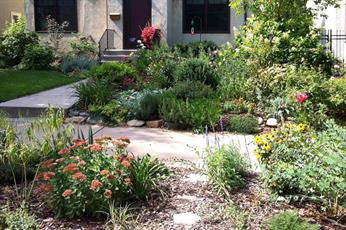

How to plant for clean water. With the right landscaping, you can minimize runoff and protect our lakes from pollution.
We often talk about how to plant a water-efficient landscape that requires less water to thrive. We also believe strongly in minimizing run-off by not over-watering your lawn, to not only save water but also minimize pollution in our waterways. But, did you know that with careful planning, you can create a landscape that provides additional reduction of the amount of water running off into storm drains?
How to Create a Clean Water Landscape
Native Gardens
 When you have an area on your property where grass is not appropriate or will not grow, choosing native Minnesota plants is the best way to use the least amount of water, have little run-off, reduce air pollution, and create a wonderful habitat for beneficial animals such as birds, bees, and butterflies. Blue Thumb has created a plant finder tool so you can find the best types of native plants for your yard based on sun exposure and soil types. Some of the popular recommendations include Aster, Columbine, Milkweed, American Plum tree, the Ohio Buckeye tree, and many many more.
When you have an area on your property where grass is not appropriate or will not grow, choosing native Minnesota plants is the best way to use the least amount of water, have little run-off, reduce air pollution, and create a wonderful habitat for beneficial animals such as birds, bees, and butterflies. Blue Thumb has created a plant finder tool so you can find the best types of native plants for your yard based on sun exposure and soil types. Some of the popular recommendations include Aster, Columbine, Milkweed, American Plum tree, the Ohio Buckeye tree, and many many more.
Low Maintenance Turf
Choose your grass variety wisely. The commonly used Kentucky bluegrass requires more water, fertilizer mowing, and pesticides than low-maintenance mixes. Various brands offer low maintenance grass seed mixes, sometimes labeled as “low mow” or “no-mow” that you can use to over seed your current lawn to make the switch. The mix likely will include a variety of red fescue, tall fescue, sheep fescue, chewings fescue or hard fescue.
Low maintenance grasses are drought tolerant, require less fertilizer and are slow-growing. Many fescue varieties do well in the shade and sun. Check out bluethumb.org for tips on making the transition and for maintenance tips for your new turf.
Raingardens
You might think of raingardens as a great solution for yard drainage issues. But they are actually a fantastic way to filter stormwater before it can carry fertilizers, pesticides and other contaminants to local lakes and rivers. Ideally, your raingarden would be situated in a spot where a majority of your yards runoff passes through it before it gets to the storm drain. Check out Blue Thumb’s guide for creating a raingarden. They also feature a listing for local service providers who can design and build on for you.
At Conserva Irrigation of the Twin Cities, one of the three core values we were founded on is responsibility. Being a responsible patron of this Earth means so much more than using less water and throwing your plastic in a recycling bin. With many small actions in our every day lives, like a change in our plant choices, an adjustment in our landscape design, or choosing a different grass seed can make a world of difference. We’ll keep bringing you tips and ideas and if you ever feel your irrigation system could be optimized or upgraded for better water efficiency, give us a call. We are your partner for SMART irrigation.
Not sure? We offer a FREE sprinkler system inspection to help you find out how efficient your sprinkler is and could be.
